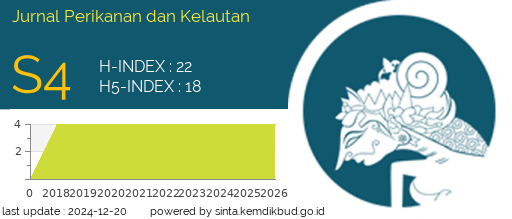Histopathology of Gills and Liver of Tilapia (Oreochromis niloticus) Infected with Streptococcus agalactiae and Fed with Fermented Herbal Medicine
DOI:
https://doi.org/10.31258/jpk.30.2.219-226Keywords:
Fermented Herbal Medicine, Streptococcus agalatiae, HistologyAbstract
Streptococcus agalactiae is a pathogen that causes significant losses in tilapia (Oreochromis niloticus) aquaculture. One alternative control is the use of natural ingredients such as fermented herbs. This study aims to analyze changes in the histopathological structure of the gills and liver of tilapia fish fed with feed containing fermented herbs after being infected with S. agalactiae. The research was conducted from March to December 2023 at the Laboratory of Parasites and Fish Diseases, Faculty of Fisheries and Marine Sciences, Universitas Riau and Bukittinggi Veterinary Center. The method used was a one-factor, completely randomized design (CRD) with five treatments and three replicates. The treatments consisted of negative control (Kn), positive control (Kp), and three feed treatments with fermented herbal medicine doses of 100 (P1), 125 (P2), and 150 mL/kg feed (P3). S. agalactiae infection was carried out on day 31 at a dose of 10⁸ CFU/mL. The results showed that the P3 treatment gave the best results, characterized by minimal damage to gill tissue (only hypertrophy) and liver (mild vacuolar degeneration) and the highest survival rate of 83.33%. In conclusion, adding fermented herbal medicine at a dose of 150 mL/kg feed can increase the immunity of tilapia against S. agalactiae infection, as shown through the improvement of organ tissue structure and improved survival
Downloads
References
Dai, C., Lin, J., Li, H., Shen, Z., Wang, Y., Velkov, T., & Shen, J. (2022). The Natural Product Curcumin as an Antibacterial Agent: Current Achievements and Problems. Antioxidants, 11(3): 459.
Doan, H.V., Hoseinifar, S.H., Sringarm, K., Jaturasitha, S., Yuangsoi, B., Dawood, M.A., ... & Faggio, C. (2019). Effects of Assam Tea Extract on Growth, Skin Mucus, Serum Immunity and Disease Resistance of Nile Tilapia (Oreochromis niloticus) Against Streptococcus agalactiae. Fish & Shellfish Immunology, 93(1): 428-435
Fakhrudin, F. (2017). Pengaruh Serbuk Lidah Buaya (Aloe vera) terhadap Hematologi Ikan Jelawat (Leptobarbus hoevenii) yang Diuji Tantang Bakteri Aeromonas hydrophila. Jurnal Ruaya : Jurnal Penelitian dan Kajian Ilmu Perikanan Dan Kelautan, 5(2): 44–54.
Fitriani, R.N., Sitasiwi, A.J., & Isdadiyanto, S. (2020). Struktur Hepar dan Rasio Bobot Hepar terhadap Bobot Tubuh Mencit (Mus Musculus L.) Jantan setelah Pemberian Ekstrak Etanol Daun Mimba (Azadirachta Indica A. Juss). Buletin Anatomi dan Fisiologi, 5(1): 75–83.
Fransiska, D.I., Riauwaty, M., & Syawal, H. (2019). Histopathology of Intestine and Liver of Oreochromis niloticus Fed with Herbs Fermented and Infected with Aeromonas hydrophila. Jurnal Akuakultur Sebatin, 5(2): 175-183.
Gaol, D.P.L., Riauwaty, M., & Syawal, H. (2024). Histopatologi Insang Ikan Jambal Siam (Pangasianodon hypophthalmus) yang Terinfeksi Aeromonas hydrophila dan Diobati dengan Larutan Kulit Kayu Manis (Cinnamomum burmannii). Jurnal Ilmu Perairan (Aquatic Science), 12(1): 21-29.
Indriati, P.A., & Hafiludin, H. (2022). Manajemen Kualitas Air pada Pembenihan Ikan Nila (Oreochromis niloticus) di Balai Benih Ikan Teja Timur Pamekasan. Juvenil: Jurnal Ilmiah Kelautan dan Perikanan, 3(2): 27-31.
Juanda, S.J., & Edo, S.I. (2018). Histopatologi Insang, Hati, dan Usus Ikan Lele (Clarias gariepinus) di Kota Kupang, Nusa Tenggara Timur. Saintek Perikanan: Indonesian Journal of Fisheries Science and Technology, 14(1): 23-29.
Koniyo, Y. (2020). Analisis Kualitas Air pada Lokasi Budidaya Ikan Air Tawar di Kecamatan Suwawa Tengah. Jurnal Technopreneur (JTech), 8(1): 52-58.
Oktafa, U., Suprastyani, H., Handayani, S., Gumala, G.A., Fatikah, N.M., Wahyudi, M., ... & Pratama, R. (2017). Pengaruh Pemberian Bakteri Lactobacillus plantarum terhadap Histopatologi dan Hematologi Ikan Patin Jambal (Pangasius djambal) yang Diinfeksi Bakteri Edwarsiella tarda. JFMR (Journal of Fisheries and Marine Research), 1(1): 31-38.
Puspitasari, D.L. (2017). Efektivitas Suplemen Herbal terhadap Pertumbuhan dan Kelulushidupan Benih Ikan lele (Clarias gariepinus). Jurnal Ilman, 5(1): 53-59.
Rifa’i, M. (2018). Laporan Kegiatan PPDH Rotasi Patologi Anatomi Veteriner yang Dilaksanakan di Laboratorium Patologi Anatomi Veteriner Fakultas Kedokteran Hewan. Program Pendidikan Profesi Dokter Hewan. Fakultas Kedokteran Hewan. Universitas Brawijaya. 34 p.
Sa'adati, F.T., & Andayani, S. (2022). Analisis Kesehatan Ikan Berdasarkan Kualitas Air pada Budidaya Ikan Koi (Cyprinus sp.) Sistem Resirkulasi. JFMR (Journal of Fisheries and Marine Research), 6(3): 20 – 26.
Safratilofa, S. (2017). Histopatologi Hati dan Ginjal Ikan Patin (Pangasionodon hypopthalmus) yang Diinjeksi Bakteri Aeromonas hydrophila. J. Akuakultur Sungai dan Danau, 2(2): 83 – 88.
Selvi, N.Z., Riauwaty, M., & Syawal, H. (2016). Histopathology Kidney of Pangasisus hypopthalmus that are Immersed in Curcumin and Were Infected by Aeromonas hydrophila. Jurnal Online Mahasiswa, 3(2):1-11.
Sirimanapong, W., Thompson, K.D., Shinn, A.P., Adams, A., & Withyachumnamkul, B. (2018). Streptococcus agalactiae Infection Kills Red Tilapia with Chronic Francisella noatunensis Infection More Rapidly than the fish Without the Infection. Fish and Shellfish Immunology, 81(1): 221- 232.
Suhermanto, A., Herdianto, H., Suhermin, S., Ridwan, R., & Nurmawanti, I. (2019). Karakteristik Bakteri Streptococcus agalactiae NP104O, S01-196-16 dan NMbO Penyebab Streptococcosis pada Ikan Nila (Oreochromis niloticus). Jurnal Airaha, 8(2): 114 – 120.
Sulastri, I.J., Zakaria, Z., & Marusin, M. (2018). Struktur Histologi Usus Ikan Asang (Osteochilus hasseltii C.V.) yang Terdapat di Danau Singkarak, Sumatera Barat. Jurnal Metamorfosa, 2(1): 214-218.
Syawal, H., Riauwaty, M., Nuraini, N., & Hasibuan, S. (2018). Pemanfaatan Pakan Herbal (Jamu) untuk Meningkatkan Produksi Ikan Budidaya. Buku Teknologi Tepat Guna. Universitas Riau Press. Pekanbaru. 16p
Syawal, H., Pamukas, N.A., & Asiah, N. (2017). Pakan Jamu untuk Ikan Budidaya. Buku Teknologi Tepat Guna. Pekanbaru: Universitas Riau Press. 16 p.
Syawal, H., Riauwaty, M., Nuraini, N., & Hasibuan, S. (2019). Pemanfaatan Pakan Herbal (Jamu) untuk Meningkatkan Produksi Ikan Budidaya. Dinamisia : Jurnal Pengabdian kepada Masyarakat, 3(1): 188–193.
Wahyuni, S., Windarti, W., & Putra, R.M. (2017). Studi Komparatif Struktur Jaringan Insang dan Ginjal Ikan Gabus (Channa striata, BLOCH 1793) dari Sungai Sibam dan Sungai Kulim Provinsi Riau. Jom Faperika Unri, 4(2): 1–14.
Wahyuningtyas, P., Sitasiwi, A.J., & Mardiati, S.M. (2018). Hepatosomatic Index (HSI) dan Diameter Hepatosit Mencit (Mus musculus L.) setelah Paparan Ekstrak Air Biji Pepaya (Carica papaya L.). Jurnal Biologi, 7(1): 8-17.
Windarti, W., Simarmata, A.H., & Eddiwan, E. (2017). Buku Ajar Histologi. Unri Press. Pekanbaru. 105 p.
Yaningsih, N.P., Iskandar, I., & Mulyadi, M. (2018). Pengaruh Padat Tebar terhadap Pertumbuhan dan Kelulushidupan Benih Ikan Nila Merah (Oreochromis niloticus) dengan Teknologi Bioflok pada Air Rawa Gambut. Jurnal Online Mahasiswa Fakultas Perikanan dan Ilmu Kelautan Universitas Riau
Downloads
Published
Issue
Section
License
Copyright (c) 2025 Romensius Anggi AW Siallagan, Henni Syawal, Morina Riauwaty (Author)

This work is licensed under a Creative Commons Attribution 4.0 International License.






